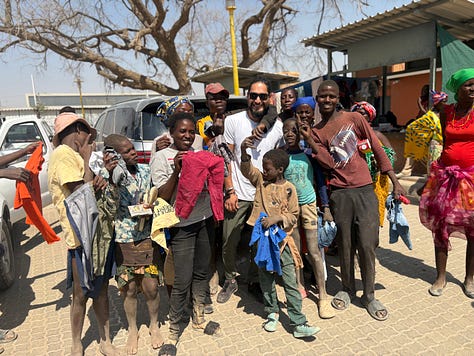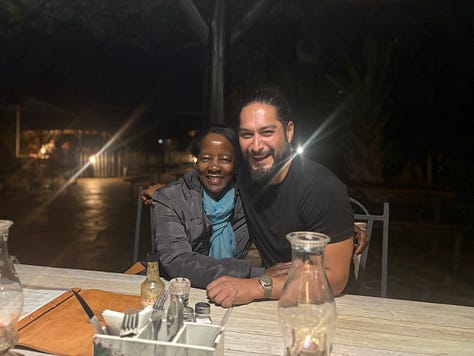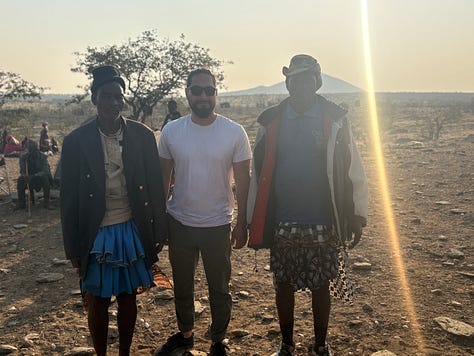My Theories and Methods for this Study of Religions
Showing up and Talking, Dead Body Politics, and Ancestral Religions
Discovering a Field
In my mid-twenties, I returned to college after several failed attempts, determined, this time, to focus on Religious Studies, the Study of Religions, or Religionswissenschaft, if you want to church it up a bit. I added English as a second major for practical purposes (which would be my first ticket to Namibia as an English teacher), but what really carried me was studying “religion” itself. After my gen-eds at Pitt Community College, I transferred and signed up for the usual survey courses offered at East Carolina University: World Religions, Buddhism, Christianity, Old Testament, New Testament, and Paul’s Letters. In the Bible Belt, the program leaned heavily toward Judeo-Christian traditions.
The turning point was an upper-level course, Theories and Methods in the Study of Religions with Professor Mary Nyangweso, a Kenyan scholar of African Religions. The central text for her class was Daniel L. Pals’ Eight Theories of Religion (now bumped up to Ten Theories, I believe) with supplemental texts to push the conversation further. We worked through the history, maybe more aptly evolution, of the field. Professor Nyangweso led the class. The only other student who seemed to consistently do the reading was a woman (let’s say grandma-age), taking courses in religion to help with her novel about Renaissance Europe, if I recall correctly. The three of us often carried the conversations with great enthusiasm and, at times, healthy contentions. That room is where I discovered that I cared more about theories, methods, and definitions of religion than any single tradition.
The first provocation that kept me up sleepless nights was the revelation that there is no consensus definition of religion. We read our way through some of the classic definitions. Folks, like David Hume, describe religion as the projection of our deepest “hopes” and “fears,” rooted in human psychology. Alternatively, Emilé Durkheim frames religion as “Society” worshipping itself in the form of gods. Anthropologist, Clifford Geertz, treats religion as a cultural system of “symbols” that shaped “moods and motivations.” Yet, Talal Asad pushes back, showing how those symbols only make sense within histories of “power” and “discourse.” Most provocative, J. Z. Smith cut further still, insisting that religion is not a natural or universal category at all but is the “creation of the scholar’s study.”
Each definition felt persuasive until the next one knocked it down. That constant turn of clarity and contradiction was both energizing and frustrating. If we are all studying religion, what exactly is that object of study? Later seminars at the University of Chicago gave me a way forward. During an evening class, a discussion emerged about the distinction between an academic discipline and field, an important bifurcation that had never crossed my mind.
It was argued that ours is less a single discipline which would share a methodological approach to study a multitude of objects. In contrast, I was joining a field of study that uses a multitude of methods to analyze a specific object of inquiry. In this sense, the Study of Religions is a field organized around a shared interest, different theories, different methods, different definitions, same object. However, that framing did not resolve the problem, yet it gave me a way to proceed. Rather than chase a universal definition of religion, I could stipulate one for a given project, state my boundaries, and then do the work to defend it.
And so, at some point on this journey through academia, one must muster up enough scholastic courage to call out an object, identify it as such, and argue for the sustainability of that identification based on the experience of the research at hand. I hope to be nearing such courage now.
Method First: Showing Up and Talking
Years later, in Namibia, the classroom debates met practice. I began fieldwork assuming I should imitate “thick description,” à la Clifford Geertz (Cliff Notes, if you will), careful notes, cameras ready, recording every detail. In some ways, it worked. But, in truth, this method did not fit me. What actually came to work better for me was much simpler. I show up, introduce myself, explain why I am in that given space, and begin talking.
Where I show up has been deliberate. Because I want to study religion, I have placed myself first in sacred and commemorative spaces. I sat at the holy fire. I visited gravesites. I stood at commemorations tied to the genocide. I attended independent church services. I eventually carried that same posture into the archives. These are the places where religion is lived and remembered, and I wanted to be present where those claims were being made.
From the holy fire, I moved to the Oruuano Church and related events. From there to Red Flag Day commemorations and other gatherings, each new location was informed by previous conversations and earmarked as places of interest for my developing project.
Along the way, I was drawn into debates about restitution, repatriation, and reparations. OvaHerero leaders and activists like Jeptha Nguherimo, Laidlaw Peringanda, along with scholars both formal and informal like, Johanna Kahatjipara, Chief Tjambiru, Steeve Buckridge, and Dag Henrichsen became guides. Consistent presence earned enough trust for longer and more candid exchanges. Over time, I developed the conversational chops to extend the breadth and depth of these exchanges. I learned enough language, history, and cultural references to sustain dialogue across settings.
Only after that did the conversations move into social spaces. Book launches. Bars and restaurants. Airports and taxis. Those places mattered; but they became available, because I had first grounded myself in sacred and commemorative contexts. The method is not complex. Show up where religion is practiced. State your presence. Carry a descriptor that situates you. Listen closely. Ask to record when the conversation turns.
And so, every arrival comes with a statement of presence, a title. Sometimes I introduce myself as a student, sometimes as a researcher, eventually as a PhD candidate. Those titles are not neutral. They shape conversations in direct and indirect ways.
At times, they open doors. At times, they prompt people to read me as a validator of Christian or post-missionary experiences. At other times, I am treated as a recorder for, or extension of, another extractive university project. Rarely have I had the time to fully explain my own “moods and motivations” that initiated the project. Either way, my introduction and description of presence helps to determine what people share and how they share it.
Theory Next: Dead Body Politics
Method gave me material. Graduate seminars gave me a scaffold for thinking with it. The theory of dead body politics studies how the treatment, movement, and memorialization of the dead give shape to political, social, and religious life (Thomas Laqueur, Katherine Verdery, Michael Herzfeld, Diana Espirito Santo, Jan Assman).
I was first introduced to the theory by a peer whose work explores contemporary Confederate memory-making through monuments, reenactments, and ghost hunting at sites significant to Confederate history, super interesting stuff. And, this theoretical lens put into clearer perspective what I was seeing in Namibia. It clarified much of the work I had been struggling to contextualize in my own writings.
The mass graves from the 1904-08 genocide are not distant history. They remain present in monuments, commemorations, and family narratives. They continue to shape OvaHerero identity. Dead body politics helped me explain why a holy fire, a gravesite, or a commemorative day still carries force in the present. The theory helps link ritual to memory, memory to identity, and identity to power.
I also found myself extending the theory. Classic versions of dead body politics focus on the physical remains of the dead and their placement or inanimate commemorative monuments that solidify particular historical narratives. But in Namibia, ancestors are not only remembered. They are treated as living presences. The holy fire is not simply a place of memory. It is a place where ancestors are believed to gather and speak. Stretching this theory to account for ancestral presence allowed me to hold both their graves and their guidance in clearer view.
The framework also lets me connect the local and the national. Conversations at fires and churches sit alongside debates about restitution, reparations, and repatriation of confiscated OvaHerero skulls. Family rituals sit alongside independence movements and public commemorations. Dead body politics gives me the map to keep those terrains oriented.
Definition Last: Where Ancestors Roam
The combination of method and theory led me back to definition. The classroom debates never ended. There remains no single definition accepted by those who study the object of religion, and rightly so. What changed is how I work with that fact. Rather than search for a universal, I adopt a working definition for the purposes of my project and then show why that definition makes sense in relation to my experiences in Namibia, with Namibians.
And so, for this work, religion is where ancestors roam. It is where the dead engage the living through memory, through presence, and through their impacts to the daily experiences of those that recognize and revere their contributions to life. Religion, here, means ancestral worship, reckoning with the dead, and recognizing how the dead shape the worldview and practices of the living. It includes holy fires, graves, commemorations, church services, and, most importantly, the stories that hold them together. It is stipulative, not universal. It is clear enough to ground an argument and bounded enough to be tested.
This definition stands on two legs. Dead body politics provides the theoretical support while the methodology of showing up and talking provides the lived material. If a reader accepts the boundaries, they can follow the analysis. If a reader rejects it, the disagreement is at least visible. Either way, I hope that my claim is clear.
Conclusion
The order matters. Method came first. By showing up in sacred spaces, stating my presence, and reciting various titles that shaped expectations, I learned how religion is lived for many OvaHerero and OvaHimba Namibians. Theory came next. Dead body politics gave me the framework to interpret what I was already encountering, and I extended it to account for ancestors as active presences. Definition came last. With method and theory in place, I could stipulate religion as where ancestors roam.
This path did not begin in the field alone. It began in that ECU classroom where I first learned how definitions of religion pile up and fall apart. It continued through fieldwork, where presence and conversation proved more effective than “thick description.” It carried into graduate seminars, where theory gave me a scaffold for what I was already living. Each step fed the next. The work continues in the same pattern: show up, state why you are there, let the titles do their work, listen, use theory to hold the pieces together, and define the objects of study so others can see what you are doing and why.
Exploring this process and the steps along the way will be the focus of this Substack for a while. Deeper dives into the benefits and limitations of this methodological approach, a fuller understanding of dead body politics and related theories, and further explanations of the definitional boundaries and justifications for such interpretations will all be necessary stopping points for more reflections. And, somewhere along the way, the idea and hope is that a dissertation will emerge out of this reflective process and space.
So, thank you for joining the journey.




